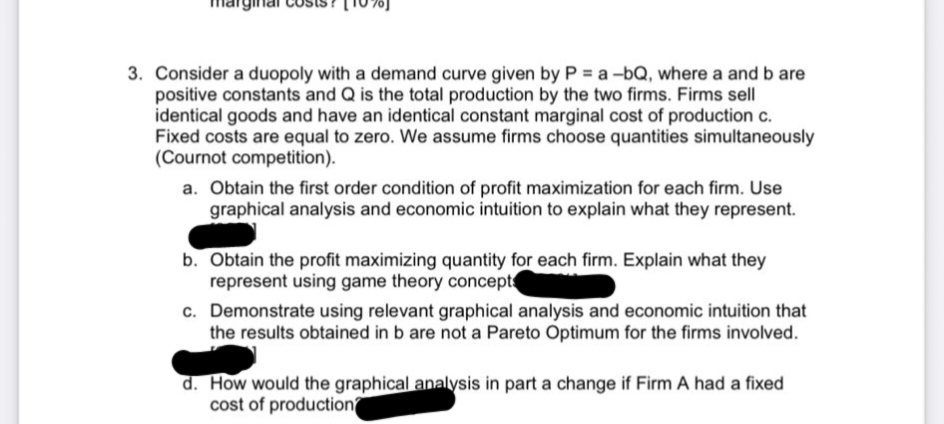3. Consider a duopoly with a demand curve given by P = a-bQ, where a and b are positive constants and Q is the total production by the two firms. Firms sell identical goods and have an identical constant marginal cost of production c. Fixed costs are equal to zero. We assume firms choose quantities simultaneously (Cournot competition). a. Obtain the first order condition of profit maximization for each firm. Use graphical analysis and economic intuition to explain what they represent. b. Obtain the profit maximizing quantity for each firm. Explain what they represent using game theory concepts c. Demonstrate using relevant graphical analysis and economic intuition that the results obtained in b are not a Pareto Optimum for the firms involved. d. How would the graphical analysis in part a change if Firm A had a fixed cost of production
3. Consider a duopoly with a demand curve given by P = a-bQ, where a and b are positive constants and Q is the total production by the two firms. Firms sell identical goods and have an identical constant marginal cost of production c. Fixed costs are equal to zero. We assume firms choose quantities simultaneously (Cournot competition). a. Obtain the first order condition of profit maximization for each firm. Use graphical analysis and economic intuition to explain what they represent. b. Obtain the profit maximizing quantity for each firm. Explain what they represent using game theory concepts c. Demonstrate using relevant graphical analysis and economic intuition that the results obtained in b are not a Pareto Optimum for the firms involved. d. How would the graphical analysis in part a change if Firm A had a fixed cost of production
Chapter15: Imperfect Competition
Section: Chapter Questions
Problem 15.3P
Related questions
Question

Transcribed Image Text:3. Consider a duopoly with a demand curve given by P = a -bQ, where a and b are
positive constants and Q is the total production by the two firms. Firms sell
identical goods and have an identical constant marginal cost of production c.
Fixed costs are equal to zero. We assume firms choose quantities simultaneously
(Cournot competition).
a. Obtain the first order condition of profit maximization for each firm. Use
graphical analysis and economic intuition to explain what they represent.
b. Obtain the profit maximizing quantity for each firm. Explain what they
represent using game theory concepts
c. Demonstrate using relevant graphical analysis and economic intuition that
the results obtained in b are not a Pareto Optimum for the firms involved.
d. How would the graphical analysis in part a change if Firm A had a fixed
cost of production
Expert Solution
This question has been solved!
Explore an expertly crafted, step-by-step solution for a thorough understanding of key concepts.
This is a popular solution!
Trending now
This is a popular solution!
Step by step
Solved in 3 steps with 2 images

Knowledge Booster
Learn more about
Need a deep-dive on the concept behind this application? Look no further. Learn more about this topic, economics and related others by exploring similar questions and additional content below.Recommended textbooks for you


Managerial Economics: Applications, Strategies an…
Economics
ISBN:
9781305506381
Author:
James R. McGuigan, R. Charles Moyer, Frederick H.deB. Harris
Publisher:
Cengage Learning

Survey of Economics (MindTap Course List)
Economics
ISBN:
9781305260948
Author:
Irvin B. Tucker
Publisher:
Cengage Learning


Managerial Economics: Applications, Strategies an…
Economics
ISBN:
9781305506381
Author:
James R. McGuigan, R. Charles Moyer, Frederick H.deB. Harris
Publisher:
Cengage Learning

Survey of Economics (MindTap Course List)
Economics
ISBN:
9781305260948
Author:
Irvin B. Tucker
Publisher:
Cengage Learning



Exploring Economics
Economics
ISBN:
9781544336329
Author:
Robert L. Sexton
Publisher:
SAGE Publications, Inc